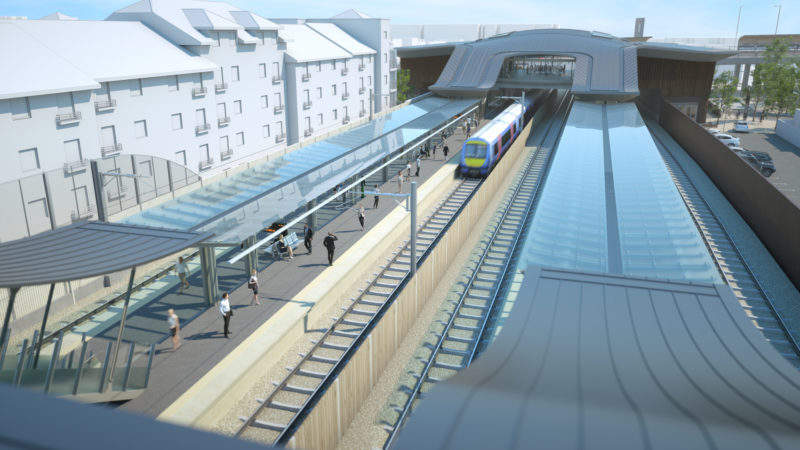
According to the Office of Rail and Road, there were 428 million UK passenger journeys in the first quarter of 2018-19 alone. London Waterloo is by far the busiest station in the country, with 99 million passenger entries and exits in the 2016-17 period. With so many travelling, getting passengers from A to B as smoothly and efficiently as possible is absolutely vital.
But a rail journey doesn’t begin and end at the platform edge; within the stations themselves, passengers must be able to navigate to the train while being distracted by the retail stores, advertisements and other passengers in their way. This is where the practice of wayfinding – the process of using information from the environment to help individuals navigate a space – comes in.
New rail stations are being designed with efficient wayfinding at their core, as a means to ensure smooth passenger flow as a central tenet, but without being able to stand in a physical space, it can be tricky for station designers and architects to sufficiently test out whether their plans are making appropriate use of signage and space.
Thankfully the emergence of immersive technology such as virtual reality has begun to allow architects to visualise their designs with increasing ease. UK design agency CCD Design and Ergonomics, together with Swedish eye-tracking technology specialists Tobii, has recently launched a combined virtual reality eye-tracking tool called Evidentia to help rail station architects gather objective feedback on their designs early on in the process, allowing for more efficient stations to be designed, with passenger navigation information at the core of their architecture.
Combining virtual reality and eye-tracking
“We’ve been developing a tool that integrates eye-tracking technology into virtual reality so that we can take people in the design team, or representative passengers, and put them in a virtual world and ask them to complete tasks,” explains CCD managing director David Watts. “[We tell them] ‘come into the station, go here, go there, find your train’ and so on but what it allows us to do is to get more objective data as to what they’re actually looking at, or perhaps more importantly, what they’re not looking at, as they complete those tasks.”
From a design perspective, being able to gather hands-on information from potential passengers on the effectiveness of plans without having to construct a physical space is absolutely invaluable. The earlier architects are able to receive such feedback, the less costly and disruptive it is to alter models, or design around the issue. For a space designed to be used by the general public, or for public infrastructure, savings on time and costs are crucially important.
“The primary purpose of this technology is to get in place a better scheme to help people navigate and to avoid having to make more costly changes later on in the design process, or even once you’ve built the station,” says Watts.
A problem for architects and designers looking to incorporate wayfinding into their designs is that they often have to rely upon subjective interviews from individuals on how they process signage information and environmental cues. This is even true when using a 3D virtual reality model that they can put representative passengers into. This is where the incorporation of eye-tracking technology shines: by interviewing passengers after their virtual journey, designers can differentiate between what the individual looked at and what they actually saw and registered.
Human-centric design in transport
Utilising immersive technology within rail station design allows architects to make better use of human-centric design. Typically, industrial design focuses on the service itself, rather than the individuals using said service. So within rail, most stations would focus more on economy of space regarding the trains and platforms themselves, rather than how passengers might navigate towards them.
Watts uses ticket gates as an example: “There are a lot of things in transport that are not there for [the passenger’s] benefit; for example gate-line technologies in a train station are there for the organisation for their revenue protection. You can understand why you need something like that in the system, and that’s perfectly acceptable, but a user-centred approach would – technology allowing – most likely end up with a different solution as to how you might approach this.”
Of course there is always the added benefit of being able to demonstrate the workings of the architectural team to end-clients, instilling confidence that all relevant aspects of the design are being taken into account, and that the cost of redrafts and remodelling will thus be less of a factor.
The Evidentia technology is not limited to rail stations, with CCD looking into airport design, as well as non-transport applications, such as galleries, museums, hospitals and hotels – essentially anywhere wayfinding has an application.
“I think the broader impact of immersive tech on the design process is going to be fascinating to see over the next few years,” says Watts. “I think it has the potential to change the design process quite significantly. At the moment you have to wait for drawings or 3D renders to get a sense of the building, but you don’t get to actually stand in it until it’s been built. This technology allows you to stand in it from day one, and I think that’s incredibly powerful.”



